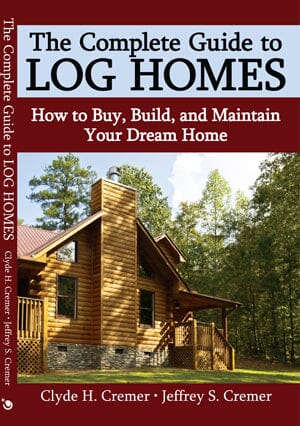Its a classic American dream: a beautiful log home nestled in the woods, standing proudly on a mountain top, poised on a hillside, or serenely overlooking a sparkling lake or stream. With walls that beautifully blend the art of nature with the hand of human labor, no other kind of dwelling so poetically expresses the pioneering, self-sufficient spirit that made this nation great.
If youre looking to make this dream a reality, let seasoned professionals Clyde and Jeffrey Cremer help you navigate the often puzzling maze of buying and building a log home. With this indispensable guide, Clyde and Jeffrey advise you on every aspect of the process, from idea stage to completed project, and explains how to choose the right style of home to fit your budget and site selection.
They also cover such topics as:
- Types of wood used for log cabins
- R value
- Wood shrinkage
- Energy efficiency
- Estimating costs
- Construction concerns
- Log home components
- Window and door selection
- Log home maintenance
- 50 Rendered illustrations and photos
- And much more!
The Complete Guide to Log Homes gives you all the information you need to make an informed, educated decision on buying or building a log home. Take the first step today toward having the home of your dreams!
Click on the technical data tab to view the table of contents.
Paperback: 192 pages
Publisher: iUniverse.com (October 26, 2008)
Language: English
ISBN-10: 0595441432
ISBN-13: 978-0595441433
Product Dimensions: 9 x 6 x 0.4 inches
Introduction
A Brief History of Log Homes
The Tree: A Wood-Producing Machine
Introduction
Parts of a Tree
Crown
Roots
Trunk
Cambium
Xylem
Heartwood
Inner Bark
Outer Bark
Wood � Factors in Insulation and Shrinkage
Heat Transfer
Thermal Resistance (R-Factor)
Thermal Mass
Airtight Log Homes
Moisture in Wood Cells
Moisture in Timber
Equilibrium moisture content
Shrinkage
Snap, Crackle, Pop
Air Dried
Kiln Dried
Tree Species Used in Log Homes
Introduction
Hardwoods
Aspen (Populus tremuloides)
Red Oak (Quercus rubra)
Softwoods
Bald Cypress (Taxodium distichum)
Douglas Fir (Pseudotsuga menziessi)
Pine
Eastern White Pine (Pinus strobus)
Lodgepole Pine (Pinus contorta)
Ponderosa Pine (Pinus ponderosa)
Red Pine( Pinus resinosa)
Southern Yellow Pines
Western White Pine (Pinus monticola)
Eastern Red Cedar (Juniperus virginiana)
Western Red Cedar (Thuja plicata)
Redwood (Sequoia sempervirens)
Engelmann Spruce (Picea engelmannii)
Northern White Cedar (Thuja occidentalis)
Atlantic White Cedar (Chamaecyparis thyoides)
Timber: Logging and Preparation
Professional Logging
Loggers
Helicopter Logging
Clear-cutting
Logging Your Own Timber
The Sawmill
Types of Logs
Cants
Random-Length Logs
Precut Logs
Handcrafted logs
Log Profiles
Round Logs
Flat/Round Logs (�D� Logs)
Square Logs
Hand-peeled
Laminated Logs
Log Siding
Log Corner Sections
Butt-and-Pass Corners
Saddle Notched Corners
Dove-Tailed Corners
Windows and Doors
Introduction
Energy Efficiency
Heat Transfer
EnergyEfficient Solutions
Insulated Glass
Low-Conductance Spacers
Tinted glass
Low E
Frames
The Future
Types of Windows
Casement
Double-hung
Single-hung
Glider or Sliding
Awning
Bay
Picture
Bow
Greenhouse
Specialty Windows
Round and Octagon
Angled Gable
Stained Glass
Doors
Introduction
Exterior Doors
Patio Doors
Sliding-Glass Doors
Swinging Patio Doors
Keeping it Together: Fastening and Sealing Methods
Fasteners
Spikes
Lag Screws
Log Screws
Thru-bolts
Sealing the Logs
Gasket
Poly-vinyl Chloride Gasket (PVC)
Impregnated Foam
Open-cell Foams
Caulk
Chinking Compounds
Backer Rod
Butt and Corner Joints
Splines
Dowels
Planning to Build
Chapter Highlights
How Much Does a Log Home Cost to Build?
Estimating costs
Doing It Yourself: Some Important Considerations
Skill Level
Time
Helping Hands
Contractor-Built Home
Selecting a Contractor
The Construction Contract
A Good Contract
Standard Forms
Licensed Contractors
Permits
Insurance and Bonding
One Contractor, One Job
Retention
Lien Wavers
Home Site Selection
Physical Characteristics
Environmental factors
Legal Issues
Building to Last
Pre-Construction Concerns
Transportation and Delivery
Grading, Clearing, and Grubbing
Construction Concerns
The Foundation
Log Construction
Drip Edges
Flashing
Porch Construction
Second-Floor Loft
Gable Ends
Electrical
Plumbing
The Roof
Truss Type
Rafter Type
Insulating the Roof
Weather-Tight Log Homes
Windows and Doors
Caring for Your Log Home
Cleaning Wood
Interior Wood Finishing
Exterior Treatments
Threats to Your Home
Fire
Decay
Insects
Termites
Subterranean termites
Formosan Termite
Prevention
Carpenter Ants
Prevention
Insects/Larva
Prevention
Powder Post Beetles (Old House Borers)
Carpenter Bees
Evaluating and Purchasing an Existing Log Home
The Basics
Roads and Access
Exterior
Interior
Buying an Existing Log Home Checklist
Conclusion
APPENDICES
APPENDIX A
APPENDIX B
APPENDIX C
APPENDIX D
APPENDIX E
Glossary
About the Authors
About American Log Homes
Index
Its a classic American dream: a beautiful log home nestled in the woods, standing proudly on a mountain top, poised on a hillside, or serenely overlooking a sparkling lake or stream. With walls that beautifully blend the art of nature with the hand of human labor, no other kind of dwelling so poetically expresses the pioneering, self-sufficient spirit that made this nation great.
If youre looking to make this dream a reality, let seasoned professionals Clyde and Jeffrey Cremer help you navigate the often puzzling maze of buying and building a log home. With this indispensable guide, Clyde and Jeffrey advise you on every aspect of the process, from idea stage to completed project, and explains how to choose the right style of home to fit your budget and site selection.
They also cover such topics as:
- Types of wood used for log cabins
- R value
- Wood shrinkage
- Energy efficiency
- Estimating costs
- Construction concerns
- Log home components
- Window and door selection
- Log home maintenance
- 50 Rendered illustrations and photos
- And much more!
The Complete Guide to Log Homes gives you all the information you need to make an informed, educated decision on buying or building a log home. Take the first step today toward having the home of your dreams!
Click on the technical data tab to view the table of contents.
Paperback: 192 pages
Publisher: iUniverse.com (October 26, 2008)
Language: English
ISBN-10: 0595441432
ISBN-13: 978-0595441433
Product Dimensions: 9 x 6 x 0.4 inches
Introduction
A Brief History of Log Homes
The Tree: A Wood-Producing Machine
Introduction
Parts of a Tree
Crown
Roots
Trunk
Cambium
Xylem
Heartwood
Inner Bark
Outer Bark
Wood � Factors in Insulation and Shrinkage
Heat Transfer
Thermal Resistance (R-Factor)
Thermal Mass
Airtight Log Homes
Moisture in Wood Cells
Moisture in Timber
Equilibrium moisture content
Shrinkage
Snap, Crackle, Pop
Air Dried
Kiln Dried
Tree Species Used in Log Homes
Introduction
Hardwoods
Aspen (Populus tremuloides)
Red Oak (Quercus rubra)
Softwoods
Bald Cypress (Taxodium distichum)
Douglas Fir (Pseudotsuga menziessi)
Pine
Eastern White Pine (Pinus strobus)
Lodgepole Pine (Pinus contorta)
Ponderosa Pine (Pinus ponderosa)
Red Pine( Pinus resinosa)
Southern Yellow Pines
Western White Pine (Pinus monticola)
Eastern Red Cedar (Juniperus virginiana)
Western Red Cedar (Thuja plicata)
Redwood (Sequoia sempervirens)
Engelmann Spruce (Picea engelmannii)
Northern White Cedar (Thuja occidentalis)
Atlantic White Cedar (Chamaecyparis thyoides)
Timber: Logging and Preparation
Professional Logging
Loggers
Helicopter Logging
Clear-cutting
Logging Your Own Timber
The Sawmill
Types of Logs
Cants
Random-Length Logs
Precut Logs
Handcrafted logs
Log Profiles
Round Logs
Flat/Round Logs (�D� Logs)
Square Logs
Hand-peeled
Laminated Logs
Log Siding
Log Corner Sections
Butt-and-Pass Corners
Saddle Notched Corners
Dove-Tailed Corners
Windows and Doors
Introduction
Energy Efficiency
Heat Transfer
EnergyEfficient Solutions
Insulated Glass
Low-Conductance Spacers
Tinted glass
Low E
Frames
The Future
Types of Windows
Casement
Double-hung
Single-hung
Glider or Sliding
Awning
Bay
Picture
Bow
Greenhouse
Specialty Windows
Round and Octagon
Angled Gable
Stained Glass
Doors
Introduction
Exterior Doors
Patio Doors
Sliding-Glass Doors
Swinging Patio Doors
Keeping it Together: Fastening and Sealing Methods
Fasteners
Spikes
Lag Screws
Log Screws
Thru-bolts
Sealing the Logs
Gasket
Poly-vinyl Chloride Gasket (PVC)
Impregnated Foam
Open-cell Foams
Caulk
Chinking Compounds
Backer Rod
Butt and Corner Joints
Splines
Dowels
Planning to Build
Chapter Highlights
How Much Does a Log Home Cost to Build?
Estimating costs
Doing It Yourself: Some Important Considerations
Skill Level
Time
Helping Hands
Contractor-Built Home
Selecting a Contractor
The Construction Contract
A Good Contract
Standard Forms
Licensed Contractors
Permits
Insurance and Bonding
One Contractor, One Job
Retention
Lien Wavers
Home Site Selection
Physical Characteristics
Environmental factors
Legal Issues
Building to Last
Pre-Construction Concerns
Transportation and Delivery
Grading, Clearing, and Grubbing
Construction Concerns
The Foundation
Log Construction
Drip Edges
Flashing
Porch Construction
Second-Floor Loft
Gable Ends
Electrical
Plumbing
The Roof
Truss Type
Rafter Type
Insulating the Roof
Weather-Tight Log Homes
Windows and Doors
Caring for Your Log Home
Cleaning Wood
Interior Wood Finishing
Exterior Treatments
Threats to Your Home
Fire
Decay
Insects
Termites
Subterranean termites
Formosan Termite
Prevention
Carpenter Ants
Prevention
Insects/Larva
Prevention
Powder Post Beetles (Old House Borers)
Carpenter Bees
Evaluating and Purchasing an Existing Log Home
The Basics
Roads and Access
Exterior
Interior
Buying an Existing Log Home Checklist
Conclusion
APPENDICES
APPENDIX A
APPENDIX B
APPENDIX C
APPENDIX D
APPENDIX E
Glossary
About the Authors
About American Log Homes
Index


